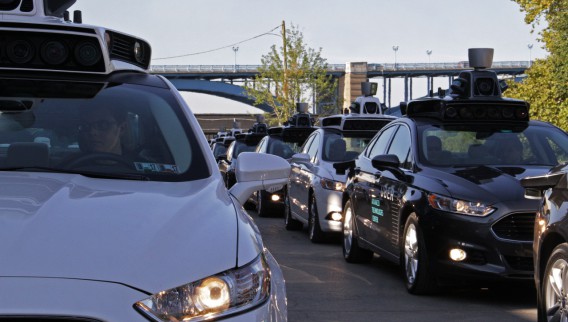
















The perceived wisdom is that Uber has disrupted taxis and that private automobiles are next, but what if we’ve misread what is happening in our cities?
Traditional thinking would suggest that UberPool, which allows users to split the cost of trips with other Uber riders heading in the same direction, will always be inferior to public transport. Sitting in the backseat of a Prius may be more comfortable than standing on a crowded bus or train, continues this reasoning, but carpooling can’t substitute for mass transit at rush hours without massively increasing congestion.
This is wrong. In the last six months, Uber has begun offering shared rides for as little as $1 (81p), introduced optimised pickup points that algorithmically recreate bus stops, and started testing semi-autonomous vehicles it hopes will solve its increasingly contentious labour issues.
Never mind the black cabs; Uber is out to disrupt the bus.
From loss-making to profitable monopoly
Its principal weapon is not renegade AVs or all-knowing algorithms; it’s cash. Back-of-the-envelope calculations suggest Uber’s passengers pay only 41% of the true cost of each ride – a figure since challenged for mistakenly including now-staunched losses in China.
Still, the figures raise red flags about Uber’s strategy: is losing $3bn annually the sign of a sustainable business, or the product of predatory pricing? “Uber is wildly unprofitable,” tweeted the economist Justin Wolfers, “[which] suggest that prices will rise once they’ve succeeded at monopolising the industry.” Perhaps to his credit, Uber CEO Travis Kalanick has never denied this.
The most important question surrounding Uber is not whether it is a platform or a transportation company, or whether its drivers are employees. It’s whether it can only recoup its investors’ billions by building a monopoly (or at least duopoly with Lyft) on the ruins of public transportation – and it may not take much to tear it all down.
In Washington DC a vicious cycle of declining ridership and service on the city’s Metro culminated in last spring’s “Metropocalypse” – a system-wide shutdown followed by a year’s worth of emergency repairs requiring the closure of entire lines for weeks at a time.
Stranded commuters abandoned transit in droves while Uber, Lyft and other services pounced, offering shared rides priced below the cost of a Metro ticket. Unsurprisingly, Metro ridership has plunged, creating a $67m shortfall in its budget.
London’s fare surge
This week’s London tube strike was a harbinger of what comes next, with stranded riders reporting Uber fare surcharges as high as 450%. As a spokesperson explained, “without this pricing, there would simply be no cars available”. Meanwhile, the number of licensed private-hire vehicles in London has nearly doubled from 59,000 in 2010 to more than 110,000 by the middle of 2016.
Ride-sharing and autonomous vehicles could prove to be an especially combustible mix if and when the technology is perfected. The Boston Consulting Group predicts a shared AV carrying three people could cost operators less on a per-mile basis than rail.
Passengers at the edge of the network would presumably be the first to defect for convenience, triggering shocks throughout the balance sheet. Even a modest decline in numbers, BCG argues, could tip well-managed transit systems into the red.
Support for public transport
So what are cities to do about the would-be disruptors tunnelling into their transit systems? First, do no harm. As the US magazine Slate recently noted, cities across America are partnering with Uber to strengthen weak transport links and then using its looming inevitability as an excuse to not improve their own service. Diverting funds to pay for blanket subsidies will only hasten the public system’s implosion.
That said, one of the rich ironies on US election day was voters’ embrace of public transport in sprawling cities such as Atlanta, Seattle and Los Angeles.
While LA Metro builds new rail lines, the city’s Department of Transportation has commissioned its own trip-planning app from Xerox, receives traffic snapshots from Waze and is exploring how best to combine various modes such as buses, bike-sharing and electric car-sharing to build a seamless system greater than the sum of its parts.
Los Angeles’ efforts trail more ambitious experiments in Helsinki, Hanover, Manchester and Birmingham, all of which are dabbling with “mobility-as-a-service” – monthly transport subscriptions combining car-sharing and taxi rides, for example, with unlimited public transport. The hope is to retain riders and woo residents away from their cars (and Uber) by making the whole of these services greater than the sum of their parts.
My own recommendations [pdf] are that simply banning Uber won’t work, and neither will battling its labour practices in court. Staving off disruption will require leveraging every tool at cities’ disposal, including lane access, parking regulations and incentives to shift the peak of rush hours commutes, to create communities that are at their best when served by mass transit – and could never be built around a million Ubers.

» Folllow me on Twitter.
» Email me.
» See upcoming events.

Greg Lindsay is a generalist, urbanist, futurist, and speaker. He is a non-resident senior fellow of the Arizona State University Threatcasting Lab, a non-resident senior fellow of MIT’s Future Urban Collectives Lab, and a non-resident senior fellow of the Atlantic Council’s Scowcroft Strategy Initiative. He was the founding chief communications officer of Climate Alpha and remains a senior advisor. Previously, he was an urban tech fellow at Cornell Tech’s Jacobs Institute, where he explored the implications of AI and augmented reality at urban scale.

----- | January 22, 2024
The Future of Generative AI in Architecture, Engineering, and Construction
----- | January 1, 2024
----- | August 3, 2023
CityLab | June 12, 2023
Augmented Reality Is Coming for Cities
CityLab | April 25, 2023
The Line Is Blurring Between Remote Workers and Tourists
CityLab | December 7, 2021
The Dark Side of 15-Minute Grocery Delivery
Fast Company | June 2021
Why the Great Lakes need to be the center of our climate strategy
Fast Company | March 2020
How to design a smart city that’s built on empowerment–not corporate surveillance
URBAN-X | December 2019
CityLab | December 10, 2018
The State of Play: Connected Mobility in San Francisco, Boston, and Detroit
Harvard Business Review | September 24, 2018
Why Companies Are Creating Their Own Coworking Spaces
CityLab | July 2018
The State of Play: Connected Mobility + U.S. Cities
Medium | May 1, 2017
Fast Company | January 19, 2017
The Collaboration Software That’s Rejuvenating The Young Global Leaders Of Davos
The Guardian | January 13, 2017
What If Uber Kills Public Transport Instead of Cars
Backchannel | January 4, 2017
The Office of the Future Is… an Office
New Cities Foundation | October 2016
Now Arriving: A Connected Mobility Roadmap for Public Transport
Inc. | October 2016
Why Every Business Should Start in a Co-Working Space
Popular Mechanics | May 11, 2016
Can the World’s Worst Traffic Problem Be Solved?
The New Republic | January/February 2016

January 31, 2024
Unfrozen: Domo Arigatou, “Mike 2.0”
January 22, 2024
The Future of Generative AI in Architecture, Engineering, and Construction
January 18, 2024
The Promise and Perils of the Augmented City
January 13, 2024